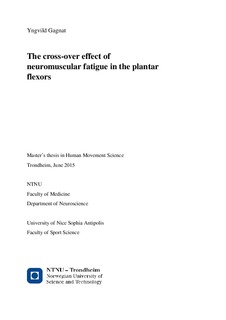| dc.description.abstract | Background Neuromuscular fatigue may be defined as an exercise-induced impairment in the ability to generate voluntary muscle force or power. This reduction in performance may occur during maximal or submaximal exercise, and the mechanisms contributing to this fatigue starts simultaneously with exercise. Fatiguability may be quantified by changes in maximal voluntary contraction (MVC) force and this muscular impairment of force capacity may be caused by peripheral or central mechanisms. Fatigue may not only affect the exercising muscles, but also other muscles not participating in the exercise. This is called a cross-over effect.
Aim The purpose of this study was to quantify neuromuscular fatigue in the plantar flexor muscles, and assess if there was a cross-over effect from the exercised leg to the contralateral, non-exercised leg. Underlying mechanisms in terms of peripheral and central fatigue was in addition investigated.
Method 13 participants, age 23.7 ± 1.9 years volunteered for this study, and attended for two testing sessions in the lab. Electromyography and force recordings were sampled. Measurements prior to (PRE) and after (POST) fatigue consisted of electrical stimulations and MVCs, and were conducted on both legs in counterbalanced order. At PRE stimulations at intensities eliciting maximal H-reflexes (Hmax) and M-waves (Mmax) amplitudes were given at rest and during four MVCs. The fatiguing tasks were performed on the right leg only (exercised leg) and consisted of three submaximal, isometric plantar flexions at 50% of MVC force, until exhaustion. The POST measurements consisted of stimulations at Mmax intensity at rest and during MVC, followed by redetermination of Hmax intensity if needed. Then stimulations at the given intensity was given at rest and during MVC.
Results The initial MVC force significantly decreased to after the fatiguing tasks, in both exercised and non-exercised leg, with about 18% and 8% respectively. One of the variable describing peripheral fatigue significantly decreased in both legs, although more pronounced in the exercised leg, with reductions of ~54% in the exercised leg and of ~15% in the non-exercised leg. There were no major changes in central parameters.
Conclusion The present study evaluating neuromuscular fatigue in the plantar flexors, found a cross-over effect to the contralateral, non-exercised leg. Peripheral mechanisms seem mainly to have attributed to the decrease in MVC force in the exercised leg, and to explain the effect of fatigue seen in the contralateral leg. Central mechanisms seems less to contribute. | nb_NO |
